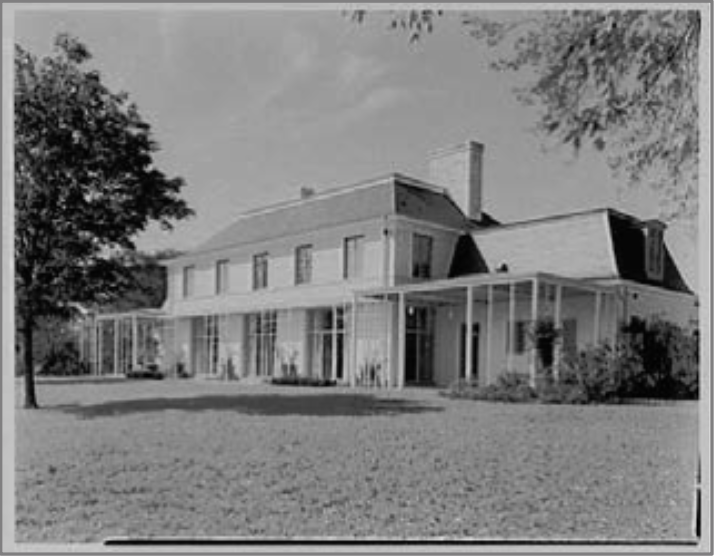The Board of Selectmen at its most recent meeting approved a $24,365 contract with a Stamford-based company to fix the roof of a town-owned building at Irwin Park.

The main house at Irwin Park. Credit: Michael Dinan
The slate roof of the 1963-built Irwin House has rubber in it and is original to the structure, according to Bill Oestmann, buildings superintendent in the Department of Public Works.
“It’s been a challenging summer, two summers actually, with the amount of rainfalls that we’ve been getting and everything, so we have started to develop some rain issues on a couple of buildings,” Oestmann told the selectmen at their Dec. 14 meeting, held in Town Hall and via videoconference. “Irwin House is no exception to that.”
First Selectman Kevin Moynihan and Selectman Nick Williams voted 2-0 in favor of the contract with J. Antonelli Roofing to repair leaks, redo damaged flashing and reset dislodged or missing slate tiles.
“I think this is a very good step to save that roof,” Oestmann said. “It’s probably a quarter-million [dollars] to replace it, so we’ve got to try and buy 10, 15 years out of it if we can.”
Irwin House served as a home to the Health and Land Use Departments during the renovation and expansion of Town Hall that wrapped up in 2015. In 2017, a selectmen-appointed committee recommended either using the structure or figuring out whether maintenance is warranted. The committee suggested that it could be a future home for the Board of Education, though the district’s headquarters now is on track to move into a newly purchased office building on Elm Street.
Town officials have suggested more recently that some parts of the New Canaan Police Department could use Irwin House as “swing space” during a renovation of the South Avenue police station.
Williams asked about long-term options for Irwin House.
Moynihan noted that the town has talked in the past about renting it out to nonprofit organizations that may need space, such as some located on Pine Street in buildings that could be redeveloped. Those talks stalled in 2018.
Moynihan said the first floor of the building is ADA-compliant and the second floor could be designated just for storage.
During the pandemic, Irwin House has been useful for COVID testing, he said.
According to a history of Irwin House written by Neele-Banks Stichnoth, “Thomas Watson, Sr. the IBM founder, bought the property at 848 Weed Street for his country home. The property included 36 acres and included a 1920’s shingle-style house and barn. The barn still exists, but a fire destroyed the original house.”
The rest of the history from Stichnoth is as follows:
“After Thomas Watson’s death in 1956 his daughter, Jane Watson Irwin, eventually inherited the property and in 1961 she and husband John Irwin II retained William & Geoffrey Platt Architects of Park Avenue in New York City to design a new house to replace the one destroyed by fire. William and Geoffrey were from good architectural stock. They were the sons of Charles Platt, noted Architect and designer of Connecticut College and Deerfield Academy. In addition to designing numerous homes in New York and New England, William & Geoffrey’s architectural projects included buildings at the New York Botanical Garden, the Pierpont Morgan Library, Harvard and Princeton Universities and Smith College. In 1962 Geoffrey Plat served as the first chairman of the NYC Landmarks Preservation Commission.
“Thomas Watson, Jr., who took over IBM in the early 1950’s, believed that “good design was good business” and led the charge to modernize and update IBM products with modern and workable solutions by hiring Eliot Noyes as a design consultant.
“This same ethos seemed to run in the family, with the design of the Watson-Irwin House. The house was completed in 1963, and is an example of transitional, classic and modern design. The architects were sensitive to scale, and what would be seen from the road in a traditional town. Yet, the back porch supports echoed and connected the main house to the modern Gores Pavilion built on the property in 1960 by Landis Gores, member of the Harvard Five.
“The house’s significance is in its physical embodiment of the development of New Canaan culturally, socially and architecturally from a primarily traditional, Colonial town to the modern thriving community it had become. Towns like New Canaan were populated with people working in very established corporations in New York City. New Canaan in particular was filled with people working at IBM, so much so, that new houses built here in the 1950’s and 1960’s were often called “IBM” colonials. William & Geoffrey Platt Architects were able to translate New Canaan’s cultural transition into architectural terms. They designed the Watson-Irwin House as the transitional crucial element in the trio of structures on the property.”


Thank you for the history. Irwin Park’s ties to the founder of IBM makes Irwin House and the whole park historically very important in the history of the birth of the computer industry. The Gores Pavilion has received much publicity for its ties to architectural history. Less publicized is the significance of the property to computer history. Also less publicized: some of the beautiful tree specimens on the grounds make the park a mini-arboretum. The New Canaan Garden Club does a beautiful job maintaining the grounds so that countless New Canaanites enjoy the beauty of this open space, whether walking, dog-walking, or visiting for other reasons. In short, the Town’s purchase of the Irwin/Watson property for a park was a most excellent purchase. I am glad to see the Town maintaining it with roof repairs.